Inov-8 TrailFly Ultra G 300 Max
Test Locations: Logan, Utah; Grand Canyon National Park, Arizona
Test Duration: 162 miles
Stated Stack Height (Midsole + Outsole): 30 mm (heel) / 24 mm (forefoot)
Stated Heel-to-Toe Drop: 6 mm
Stated Features:
- G-FLY Graphene-enhanced midsole foam provides 25% better energy return that lasts for longer
- ADAPTER-FLEX groove allows the shoe to adapt to the terrain
- G-GRIP Graphene-enhanced outsole rubber provides the world’s toughest trail traction
- Supportive upper adapts to the natural changes of the foot when running big miles
- 6mm Boomerang insole provides extra cushion and rebound
Reviewer: 6’1″, 145 lbs / 185 cm, 66 kg
Size Tested: US Men’s 11.5
Stated Weight per Shoe (US Men’s Size 9): 300 g / 10.6 oz
Blister Measured Weight (US Men’s 11.5):
- Shoes + Laces: 347 g (left) & 340 g (right)
- Insoles: 33 g (left) & 33 g (right)
- Total: 380 g (left) & 377 g (right)
MSRP: $190
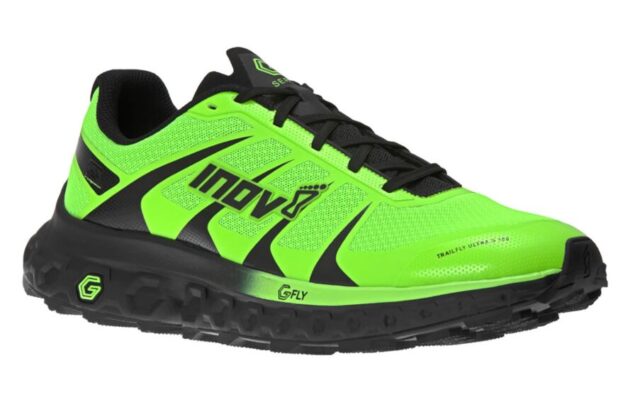
Intro
At the moment, there’s a trend of running shoe companies making high-stack shoes that are full of carbon plates and other fancy midsole technologies. That trend started out on the road-running side of things, but trail running brands are starting to hop on the bandwagon as well. Some trail brands are going for the same carbon fiber plate design found in shoes like the Nike Alphafly Next% and Hoka Carbon X2, while others are taking different approaches to making more efficient, energetic trail shoes. Inov-8’s new TrailFly Ultra G 300 Max is an excellent example of the latter category.
The TrailFly Ultra G 300 Max (aside from having a super long name) is designed for efficiency and comfort on long, off-road runs. The TrailFly’s unique feature is its “graphene-enhanced” midsole foam, which Inov-8 says provides 25% better energy return than a standard EVA midsole. Inov-8 has been using graphene to improve their shoes’ outsole durability for a couple of years now, but this is the first time the’ve added the material to the midsole as well. Inov-8 also claims that the TrailFly Ultra G 300 Max is the “first max cushioned shoe that adapts and reacts to terrain,” which strikes me as (A) a pretty bold claim and (B) pretty intriguing.
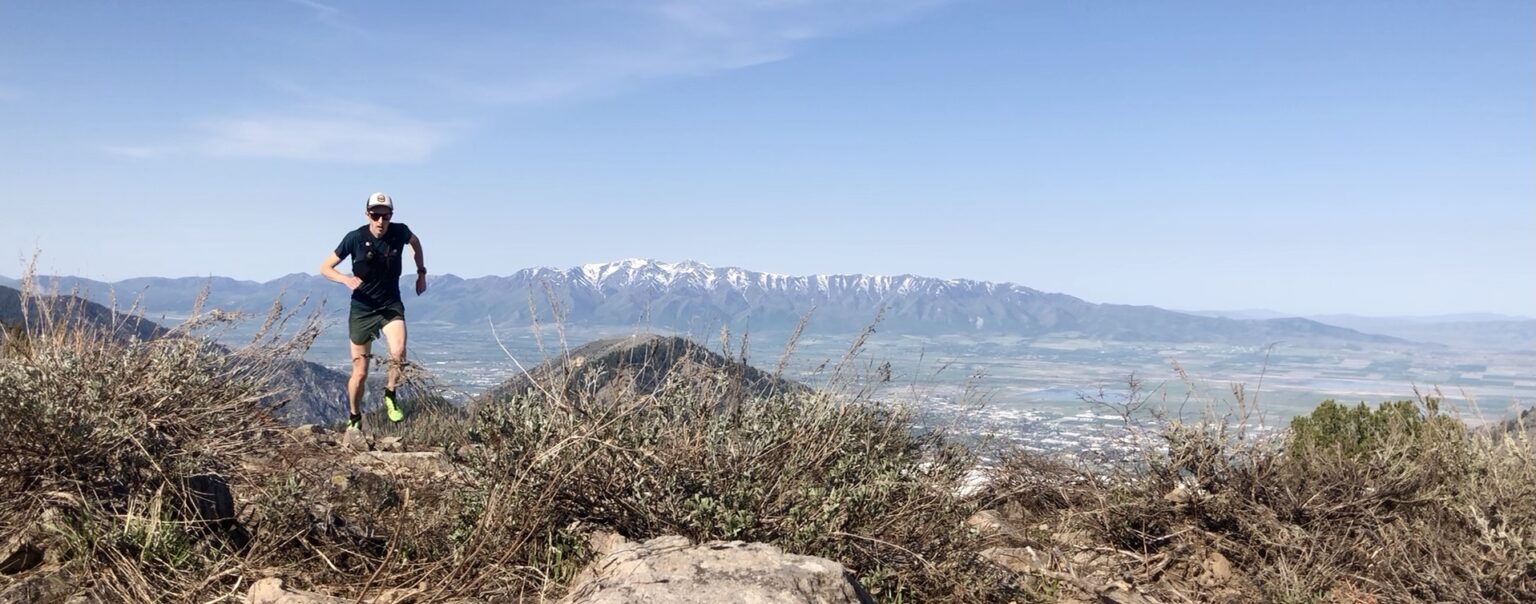
So how does the Inov-8 TrailFly Ultra G 300 Max compare to other maximal trail shoes? How about to carbon-plated road shoes? I’ve put about 162 miles on the TrailFly Ultra so far, including a 46 mile / 75 km Grand Canyon double crossing, so I’ve had a good amount of time to think about these and other questions. In this review, I’ll break down the TraiFly Ultra’s features, strong points, and potential downsides to shed some light on where the shoe might fit into your own trail shoe lineup.
Fit
As always, you should try the TrailFly Ultra in person before buying, if possible. Disclaimers aside, I’ll do my best to describe how the TrailFly Ultra fits compared to other similar shoes that I’ve run in. For reference, I have fairly narrow, low-volume feet with low arches.
Overall, the TrailFly Ultra feels very similar to the Inov-8 Terraultra G 270 — which isn’t much of a surprise, since both shoes are built on Inov-8’s widest last. The TrailFly Ultra has a fairly average-width but high-volume heel and midfoot, which makes sense for a long-distance shoe. There’s plenty of space to accommodate foot swelling (or just runners with wider / higher-volume feet), but I can also cinch down the lacing system enough to get a secure fit through the midfoot and heel.
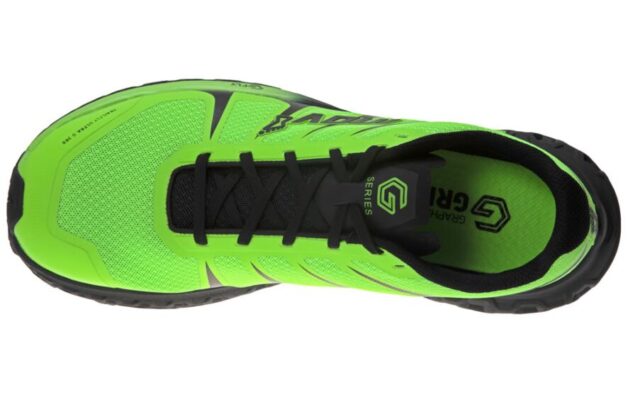
The TrailFly Ultra’s forefoot is also fairly high-volume, but it isn’t super wide. It’s wider than the Hoka One One Evo Speedgoat, but doesn’t come close to the width of the toe box on the Altra Timp 2.0 or Topo Athletic Mtn Racer — especially towards the front of the toe box. Whereas shoes like the Timp or Mtn Racer have a fairly rounded toe box (when viewed from above), the TrailFly Ultra’s toe box tapers towards the front, giving the shoe a more pointed shape. Pointy toe boxes are pretty common, but personally, I don’t think they make much sense — especially in shoes that are specifically designed for long runs. The TrailFly Ultra provides plenty of toe box space around the ball of my foot, but the tapered toe box has an unpleasant tendency to smash my toes together, especially on long downhills. Depending on your fit preferences, you may or may not have similar issues — but it’s certainly worth keeping in mind if you’re used to shoes with wide, rounded toe boxes.
As I said at the top, the TrailFly Ultra feels similar to the Terraultra G 270. The overall fit is secure and comfortable on my feet, with the exception of the front of the toe box. I have been impressed by how secure the TrailFly Ultra feels on uneven, off-camber terrain for a shoe of its size — the midfoot and heel lock down nicely and keep my feet from sliding around in the shoe without feeling as narrow / confining as shoes like the La Sportiva Bushido II Also, like the Terraultra G 270, the TrailFly Ultra seems like it should have enough extra volume in the midfoot and heel to adapt to runners with wider feet and / or higher arches, which definitely isn’t always the case for shoes that feel secure on rough terrain. I’d personally be even more stoked on the TrailFly Ultra’s fit if it had a more rounded toe box, but aside from that, I think it pretty much checks all my boxes when it comes to fit for a shoe in this class.
Weight
I’ve gone back and forth on how I feel about the TrailFly Ultra’s weight. With a stated weight of 300 g / 10.6 oz for a US Men’s 9, the TrailFly is certainly no featherweight — but at the same time, I’ve always thought that a little extra weight isn’t the end of the world as long as it’s doing something useful. The TrailFly definitely falls on the heavier end of the maximal trail shoe spectrum — but before I get too far into the weeds on whether or not that extra weight is worth its while, here’s how the TrailFly Ultra’s weight compares to similar shoes from a few other brands (all stated weights are based on a US Men’s Size 9):
264 g / 9.3 oz — Hoka One One Evo Speedgoat
272 g / 9.6 oz — Altra Timp 3
278 g / 9.8 oz — Hoka One One Challenger ATR 6
281 g / 9.9 oz — Topo Athletic Mtn Racer
295 g / 10.4 oz — New Balance Fresh Foam More Trail v1
295 g / 10.4 oz — The North Face Flight Vectiv
300 g / 10.6 oz — Inov-8 TrailFly Ultra G 300 Max
303 g / 10.7 oz — La Sportiva Jackal
306 g / 10.8 oz — Hoka One One Speedgoat 4
312 g / 11.0 oz — Nike Wildhorse 6
So while the TraiFly Ultra isn’t the heaviest shoe in its class, there are also plenty of lighter options around as well. And that definitely shows out on the trail — to me, the TrailFly Ultra does feel noticeably heavier than shoes like the Hoka One One Evo Speedgoat or Topo Athletic Mtn Racer. The TrailFly still doesn’t feel like it’s weighing me down too much, but it doesn’t feel overly light and fast, either. It is worth noting that my US size 11.5 pair of the TrailFly Ultra G 300 Max is coming in at around 379 g per shoe, and that ~80-g difference compared to the stated weight for a size 9 is a bit larger than most other shoes I review, which tend to be about ~30-50 g heavier in my size, compared to their respective stated weights for a size 9.
So why is the TrailFly heavy, and what is that extra weight doing? My best guess is that most of the shoe’s extra weight comes from its graphene-enhanced midsole and outsole. Graphene is a super light material itself, but I don’t think the TrailFly’s midsole is as light as a more traditional EVA foam (admittedly, I’m doing a bit of guesswork here). If the midsole and outsole are the main components that make the TrailFly Ultra G 300 Max a little heavier than some of its counterparts, I think they’re mostly worth it. The TrailFly Ultra’s midsole does feel springy and reactive, and the outsole does seem to be both durable and grippy — as advertised (more on both of those components later). Still, the TrailFly Ultra G 300 Max’s slightly heavier weight would definitely make me think twice before using the shoe for faster races / interval sessions. Depending on your shoe preferences, you might not even notice the TrailFly’s weight — but I do think it’s worth keeping in mind if shaving grams wherever possible is a priority.
Upper
The TrailFly Ultra G 300 Max has a fairly straightforward upper. It uses the same midweight mesh material found on the Terraultra G 270, which seems plenty breathable and durable so far. The TrailFly’s toe box has a thin toe bumper that wraps around the sides of the forefoot and ties into a set of synthetic overlays that connect the lacing system to the midsole. Lastly, the TrailFly Ultra G 300 Max’s tongue is fairly minimal, but does have a decent amount of cushion to protect the tops of your feet from the lacing system.
In practice, the midfoot overlays do a solid job of locking down the TraiFly’s fit, while the mesh provides plenty of breathability. I haven’t had any issues with overly sweaty feet in the TrailFly Ultra, even in temperatures around 90 °F / 32 °C at the bottom of the Grand Canyon. Its upper also drains quickly in wet conditions / after water crossings. I have noticed that all that open mesh lets a fair amount of dirt into the shoe in dusty conditions, but that’s to be expected from pretty much any breathable mesh upper.

I did have some issues with the tongue on the Terraultra G 270, so I was a little concerned that I’d run into similar problems with the TrailFly Ultra G 300 Max — its tongue looked pretty much the same at first glance. Fortunately, the TrailFly’s tongue comes up a bit farther than the Terraultra’s, so I haven’t had any issues with the top of the TrailFly’s lacing system cutting into my feet. Overall, the TrailFly Ultra has everything that I look for in an upper — it’s simple, secure, breathable, and durable (so far, at least).
Midsole
Alright, time for the fun stuff — The TrailFly Ultra G 300 Max’s graphene-enhanced midsole is the main feature that sets the shoe apart from its competitors. Again, the whole point of the addition of graphene, in this case, is to improve energy return and durability. Graphene is a 1-atom thick layer of carbon and has all sorts of cool properties — the most relevant in this context being that it’s extremely thin, extremely strong, and extremely flexible. So the basic idea is that, by adding graphene to the TrailFly Ultra’s midsole, the shoe can offer better energy return and it reportedly keeps the midsole foam from compacting and losing its cushion over time.
Sounds fancy, right? Fanciness aside, I’ve been pretty impressed by how the TrailFly Ultra’s midsole performs in practice. As promised, the TrailFly Ultra G 300 Max provides a great mix of cushion and energy return. Its midsole provides a more comfortable, cushioned ride than you’d get from stiffer shoes like the Topo Athletic Mtn Racer, but also provides much more energy return than softer shoes like the Altra Timp 2.0. Like the Terraultra G 270, the TrailFly Ultra also comes with Inov-8’s 6 mm “Boomerang” insole, which provides much more cushion and rebound than a traditional insole. As with the Terraultra G 270, I think that’s awesome as long as you don’t usually run with special insoles or orthotics, in which case it’s kind of a bummer that you have to miss out on the cushion / rebound provided by the Boomerang insoles.

Overall, the TrailFly Ultra’s midsole feels fairly similar to the CMEVA midsole on the Hoka One One Evo Speedgoat — which is one of the best midsoles I’ve come across in the last couple years. Both strike a nice balance between cushion and energy return that leads to a comfortable, yet efficient-feeling ride. With that said, I’m not convinced that the TrailFly Ultra’s midsole quite rises to the level of carbon-plated shoes like the Craft CTM Ultra Carbon when it comes to energy return and efficiency. Sure, the TrailFly’s G-FLY midsole feels more energetic than the standard EVA midsoles I’ve used, but it doesn’t quite provide the same extra-propulsive “pop” that I’ve noticed in shoes with rigid carbon plates.
Outsole
The TrailFly Ultra G 300 Max’s outsole also has a dose of graphene enhancement — and as with the midsole, it definitely shows. Similar to the Terraultra 270 G, the TrailFly Ultra’s G-GRIP outsole feels similar to the Vibram MegaGrip compound on shoes like the Hoka Evo Speedgoat or Topo Mtn Racer. The graphene-enhanced outsole compound provides solid grip on hard-packed surfaces, rocks (both wet and dry), and just about everything else I’ve thrown at it. The TrailFly’s 4 mm lugs don’t provide tons of grip in deep mud or on loose gravel, but that’s not much of a surprise for a shoe that’s primarily designed for longer runs on more hard-packed surfaces.
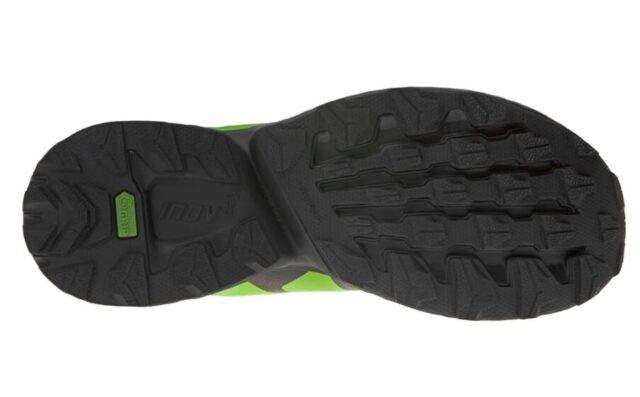
The TrailFly’s outsole also has a deep “ADAPTER-FLEX” groove that separates the forefoot and heel. The ADAPTER-FLEX groove actually extends all the way through the first layer of midsole foam, which (according to Inov-8) allows the shoe to adapt / conform to the trail surface. I have noticed that the TrailFly feels more stable on technical terrain than other maximal trail shoes (more on that later) — whether that’s all due to the ADAPTER-FLEX groove is anyone’s guess, but it seems to help. Overall, I’ve been just as impressed by the TrailFly Ultra’s outsole as I have with the outsoles on Inov-8’s other shoes — it’s as good or better on varied terrain than any other shoe I’ve tried, and it seems to be plenty durable so far as well.
On Trail
After about 162 miles in the TrailFly Ultra G 300 Max, I think it’s an almost perfect shoe for long days on technical terrain.
The G-FLY midsole provides a solid balance of cushioning and energy return, which is definitely appreciated on long days. But what really sets the TrailFly Ultra apart in my book is how well it handles steep, technical terrain — which honestly came as a bit of a surprise for me, given that it’s a shoe with a 30 mm / 24 mm stack height. The TrailFly feels smooth and efficient on even terrain, but it also feels surprisingly stable on rugged terrain. As previously mentioned, I think the ADAPTER-FLEX groove definitely plays a role here. But the shoe’s secure fit through the midfoot / heel, bomber traction, and wide platform are equally important, in my mind.
The TrailFly Ultra G 300 Max’s ride feels fairly similar to the Hoka Evo Speedgoat, but the TrailFly feels way more stable on technical terrain. Again, I attribute most of that to the TrailFly’s wider platform and secure fit, but I do think the ADAPTER-FLEX groove helps the shoe conform to steep and / or rocky trails better than shoes like the Evo Speedgoat, which have a standard single-piece midsole that doesn’t conform / mold to the terrain as well. With that said, I’d still pick the Evo Speedgoat over the TrailFly Ultra for races and interval workouts — the TrailFly feels impressively efficient for a 300 g / 10.6 oz shoe, but it’s nowhere near as fast-feeling as the lighter Evo Speedgoat at higher speeds.
That brings me to the two factors that make me say that the TrailFly Ultra is an almost perfect shoe for long days on technical terrain. First, the weight. If I’m going to be running all day, I want to be lugging around as little extra weight as possible. As I’ve said, I do think that the TrailFly has good reason to be a little heavier than some of its competitors, but the fact remains that I’d be even happier with the shoe if it didn’t weigh as much — especially because the G-FLY midsole and G-GRIP outsole feel so similar to the CMEVA midsole and Vibram MegaGrip outsole on the Evo Speedgoat, but might weigh a bit more.
Second, I’m a little leery about using the TrailFly Ultra for long runs because of its tapered toe box. As I mentioned at the top, a few weeks ago I wore the TrailFly Ultra for a 46 mi / 75 km run across the Grand Canyon and back, and I did get some pretty gnarly blisters on my little toes on both feet — probably because my toes were getting smashed together by the TrailFly’s tapered toe box for 16 hours. It is worth mentioning that I’ve had similar blisters in plenty of other shoes as well (all of which had similarly tapered toe boxes), so this issue isn’t unique to the TrailFly. Still, I think it’s a pretty good indicator that the TrailFly would benefit from a more rounded toe box, at least for my feet.
Critiques aside, I think it’s important to point out that, aside from the toe blisters, I was very happy with how the TrailFly Ultra performed on my R2R2R run. Its cushioning kept my feet from tiring out (too much), and the extra energy return from the G-FLY midsole was much appreciated later in the day. Since then, I’ve also been loving the TrailFly for super steep, technical ridge scrambles around Logan — which is definitely pretty unusual and impressive for a maximal trail shoe. With all that in mind, my conclusion is that the TrailFly is an awesome shoe for long, technical runs — and that with a few tweaks, it could be pretty close to perfect (at least for my feet and my preferences).
Durability
I’ve been able to get a pretty good assessment of the TrailFly’s durability over my first 162 miles in the shoe, and so far, I like what I see. The upper looks just like it did on day one (only dirtier), and the midsole hasn’t compacted or lost any of its energy return. The outsole is showing a little deterioration in high-wear areas like the outside of the forefoot, but that’s not too much of a surprise — I’ve mostly worn the TrailFly on super hard-packed, rocky terrain, which isn’t exactly easy on outsoles. At this point, I’m confident that the TrailFly Ultra will last several hundred more miles, but I’ll update this section down the road if I run into any unexpected durability issues.
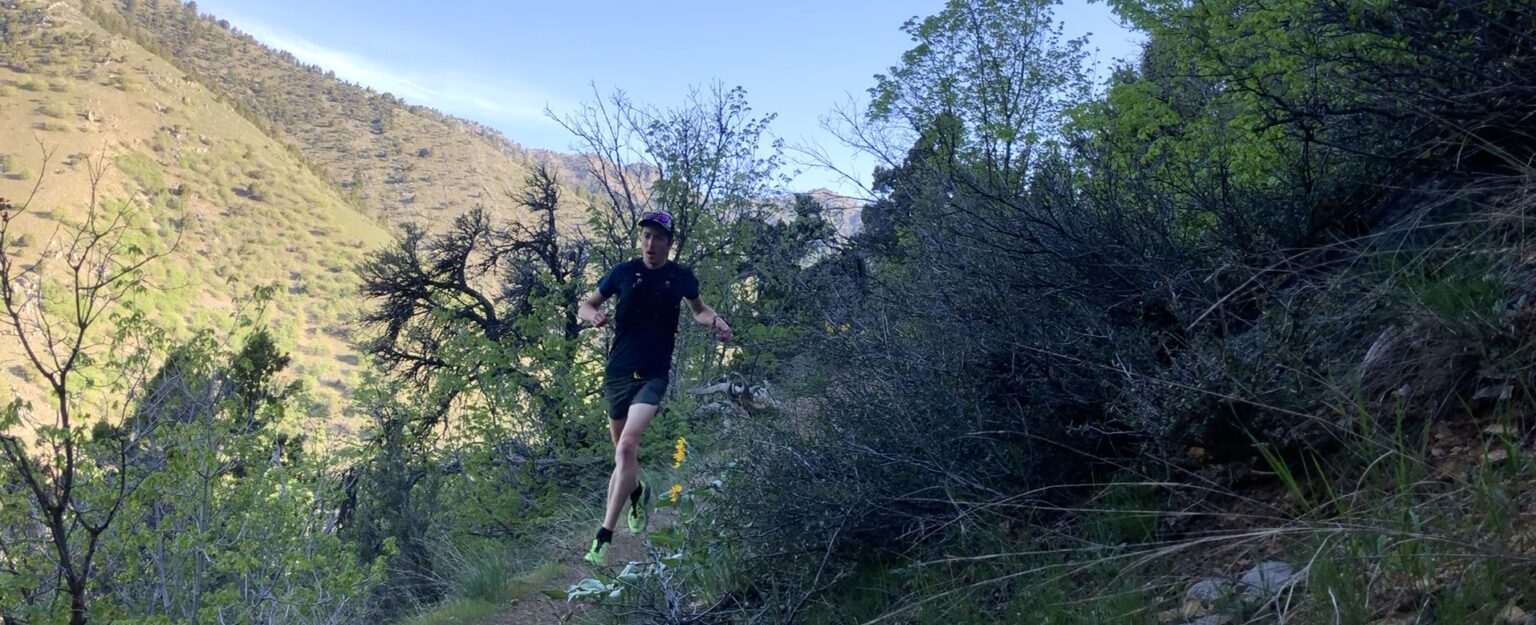
Who’s It For?
As you’ve probably picked up on by now, I think the TrailFly Ultra G 300 Max is a solid option if you’re looking for a high-cushion shoe for more technical terrain. If you’re used to ultralight shoes or shoes with wider, more rounded toe boxes, you might have some issues with the TrailFly Ultra. If not, I think the TrailFly Ultra G 300 Max is definitely worth checking out — especially if you’ve felt unstable on technical terrain in other maximal trail shoes. At $190, the TrailFly is a bit of an investment, but based on how well it’s holding up so far, I think it’s also a worthwhile one for the right person.
Bottom Line
I still think that Inov-8’s claim that the TrailFly Ultra G 300 Max is the “first max cushioned shoe that adapts and reacts to terrain” seems a little bold, but I do think that the TrailFly is one of the best shoes I’ve found for long, technical runs. In my opinion, it’d be even better if it was a bit lighter and had a more rounded, spacious toe box, but there’s a lot to like about the TrailFly as-is. If you’re looking for a high-cushion shoe that feels smooth and efficient on non-technical terrain without sacrificing stability on the gnarly stuff, I think the Inov-8 TrailFly Ultra G 300 Max should definitely be on your radar.


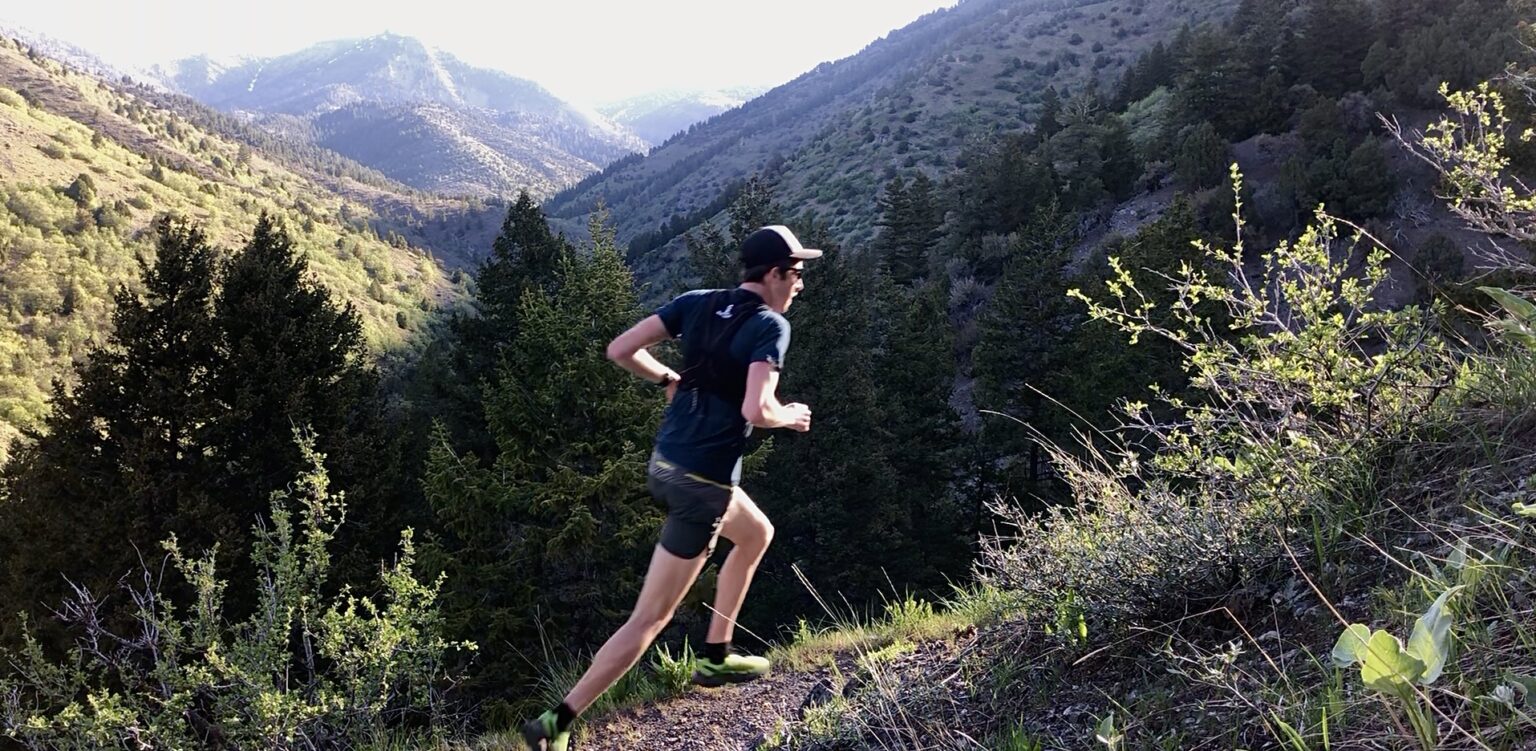
I’m a bit of a clydesdale. Dont mind the weight and need the max cush with scramble potential. Sounds like the prefect fit for me. Was wishing I had a shoe like this on the pfeifferhorn ridge recently
Good review, thanks for sharing it
Do you think going up in size at all in the 300 compared to the 270 is a valid option?
Hey Andrew – Personally I wouldn’t want to size up in the TerraFly relative to the Terraultra — while an extra half-size might give me more toe box space in the TerraFly, the shoe’s overall fit is quite a bit higher-volume than the Terraultra. Since I have fairly narrow / low-volume feet, I’d be concerned that sizing up in the TerraFly would make it hard to get a secure fit. With that said, if you have higher volume feet, you might be able to get away with going up a half size without any issues.
I’ve been using the Terraultra 270s and find the toe box roomy enough and haven’t had issues with little toe blisters like in other shoes. In your review of the 270 it sounds like you didn’t have issues with the toe box, but do with the 300s despite the same last being used? Do you feel like there is more of a taper with the 300s? Unfortunately it’s not possible to try these on where I live as Inov-8 don’t have a local distributor.
Hey Jesse – Yeah, it seems like the 300s taper a bit more than the 270s, even though they’re supposedly built on the same last. The overall width through the heel / midfoot feels similar in the Terraultra 270 and TerraFly Ultra, but the front of the TerraFly’s toe box feels a bit narrower. It’s not a huge difference, but I did feel like I had less room for toe-splay in the TerraFly than in the Terraultra.
Hey Gordon!!
I live in Layton UT and I’m trying to figure out what shoes to get. I had the terra ultra g270 as my first trail shoes and I loved them. Ground feel. Cushion. Etc. They’re worn out so I’m on the hunt. How would the g300 do on our terrain here in Utah (I run the boneville shoreline trails and head up and down the technical climbs and terrains a lot. I ask bc I have a tendency to roll my ankles. Will the the g300 be better than say a hoka speedgoat 5 or a Saucony Xodus Ultra for downhill technical stuff since the stake height is higher on those max cushioned shoes?
I’m also debating between another pair of g270s or the adidas Terrex speed ultra for those faster days. Any input would be awesome since we live in the same area. I really appreciate it!
Thanks!
Ryan